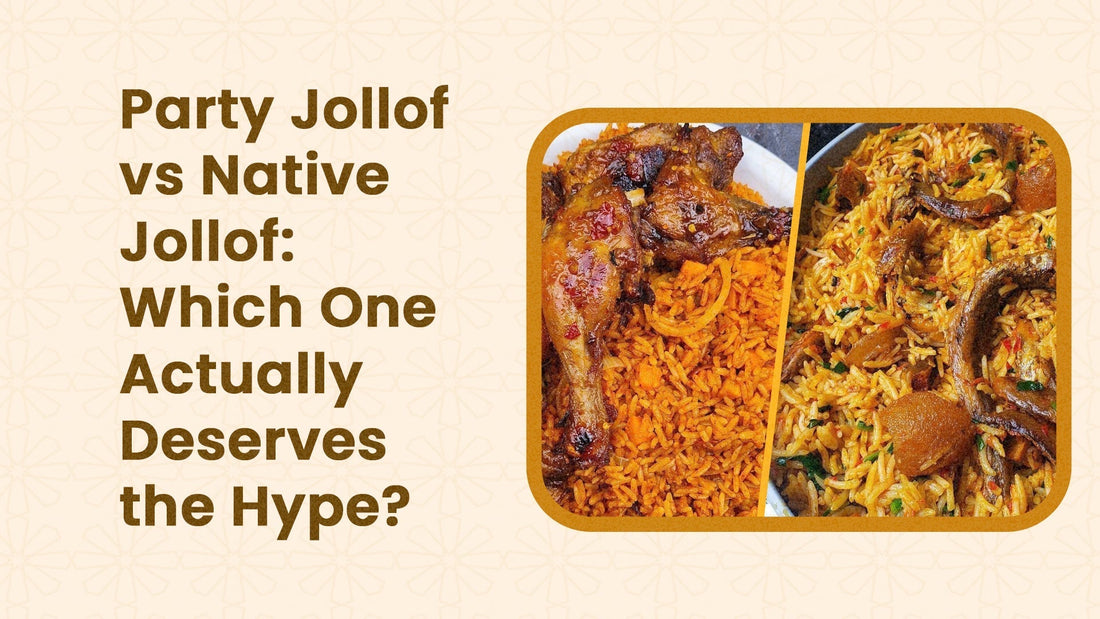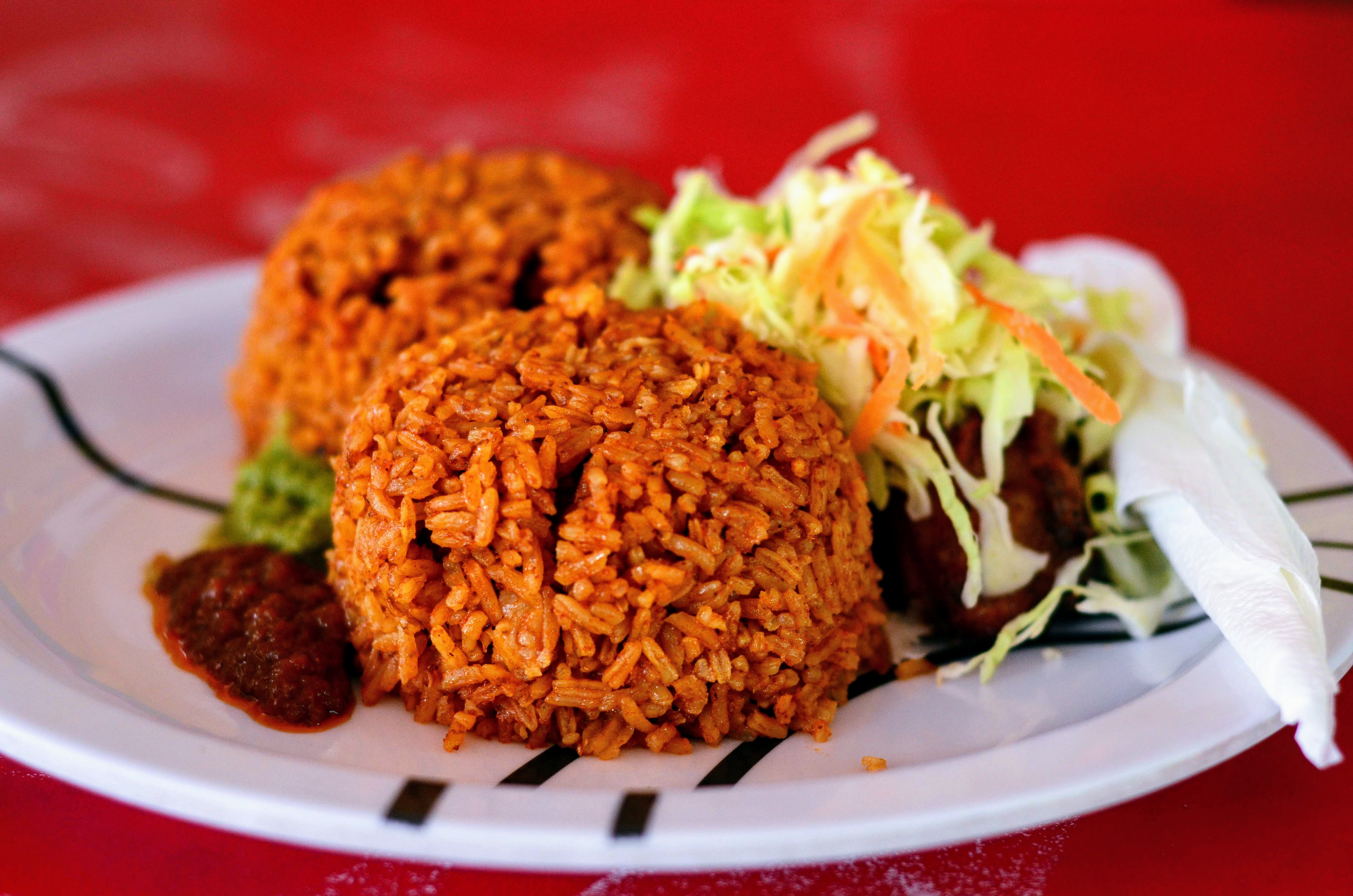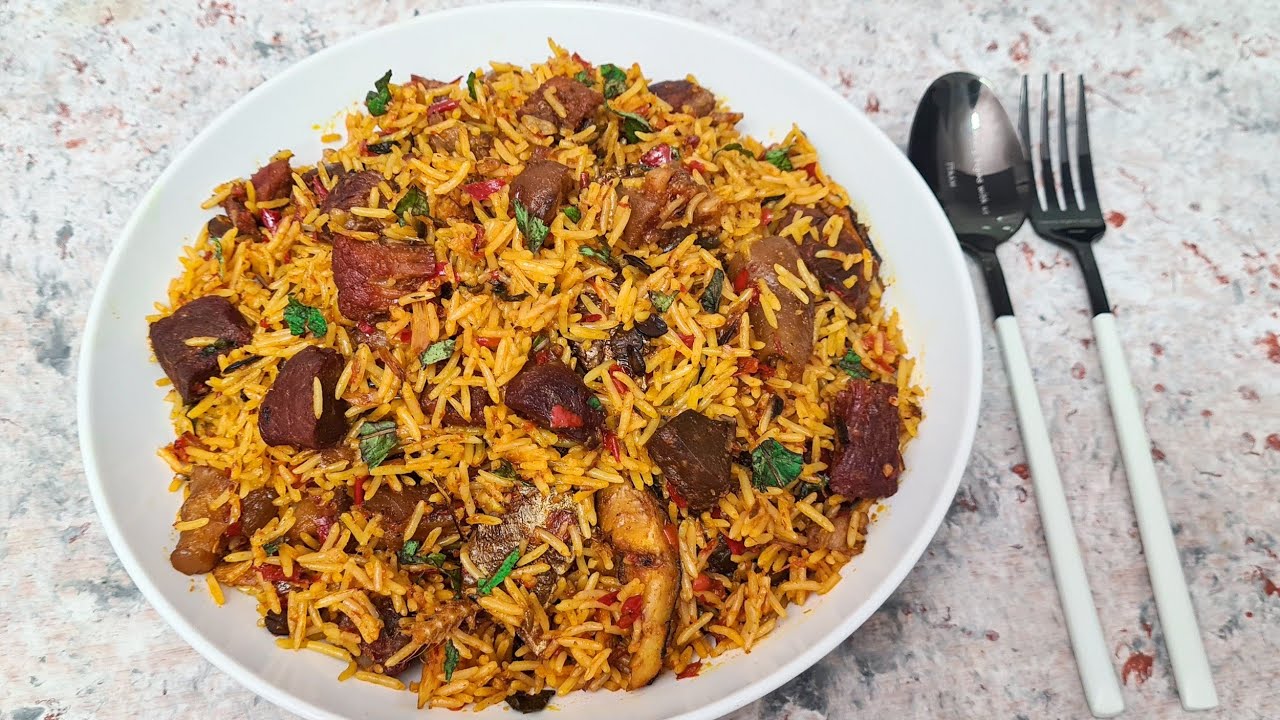
Party Jollof vs Native Jollof: Which One Actually Deserves the Hype?
Share
Let's talk about the jollof that doesn't get invited to the debate.
While Nigerians and Ghanaians fight over whose tomato-based jollof reigns supreme, there's another version sitting quietly in the corner, watching the chaos. It's older, deeper, and frankly, doesn't care about your Instagram photos.
Native jollof—also called palm oil jollof or Iwuk Edesi—is what jollof was before it became party rice. It's what happens when you strip away the tomatoes, the curry powder, the Maggi-fueled theatrics, and get back to basics: palm oil, seafood, and smoke.
So which jollof actually deserves the hype? The crowd-pleaser at every owambe, or the traditional version your grandmother makes on quiet Sunday afternoons?
Also read: 10 Kitchen Essentials You Must Have to Make African Cooking Easy
WHAT THEY ACTUALLY ARE
Party Jollof: The People's Champion

Image from: Wikipedia
Tomato-red, curry-golden, perfectly smoky. Made with tomato paste, curry powder, thyme, and enough seasoning to make every grain sing. It shows up at weddings, birthdays, naming ceremonies—if there's a celebration, there's party jollof.
The technique matters: tomato paste fried until oil separates, rice parboiled just right, that slight burn at the bottom. It's theater, precision, Nigerian food culture at its most visible.
Native Jollof: The Original Recipe

Image from: Bella Naija
This predates the tomato version by generations. Cooked in palm oil as the base, not a finishing touch. No tomatoes—instead you have crayfish, stockfish, smoked fish, sometimes snails or periwinkles. Traditional spices like ehuru, uda, and oburunbebe instead of curry.
The color is darker—deep orange-red from palm oil. The flavor is earthier, smokier, more complex. It tastes like the Niger Delta, like fishing communities, like Sunday afternoons when nobody's in a hurry.
THE FLAVOR SHOWDOWN
Party Jollof: Bright and Balanced
Party jollof hits you immediately. Tomatoes provide acidity and umami. Curry powder adds golden warmth. Thyme brings herbal notes. Seasoning cubes provide savory depth.
It's balanced, familiar, safe. Even people who don't normally eat Nigerian food can appreciate it. The best party jollof has layers—tomatoes first, then spices, then that subtle smokiness. It pairs beautifully with fried chicken, coleslaw, moi moi, dodo.
Native Jollof: Deep and Unapologetic
Native jollof doesn't care if you're ready. The palm oil hits first—earthy, slightly sweet, unmistakably African. Then seafood depth from crayfish and stockfish. Then aromatics from traditional spices with no Western equivalents.
It's richer, heavier, more intense. The flavor builds rather than announces itself. Some people take one bite and decide it's too much. Others wonder why anyone bothers with the tomato version when this exists.
Native jollof doesn't need coleslaw or fried chicken. It stands alone or pairs with simple proteins like grilled fish or boiled eggs.
THE COOKING REALITY
Party Jollof: Deceptively Difficult
Everyone thinks they can make it until they try. Tomatoes can be too acidic or watery. Rice can be mushy or undercooked. Getting perfect grain separation, that smoky bottom, that spice balance—it takes practice.
The ingredients are accessible, but accessibility doesn't equal simplicity. Party jollof humbles confident cooks.
Native Jollof: Ingredient-Dependent
Less about technique, more about ingredients. If you have good palm oil, quality stockfish, fresh crayfish, and proper spices, you're 80% there.
The cooking is more forgiving—low and slow, letting the palm oil work its magic. But those ingredients matter intensely. Bad palm oil ruins everything. Old stockfish contributes nothing. You can't fake your way through with substitutions.
THE OCCASION FACTOR
Party Jollof: The Social Butterfly
Democratic. Feeds crowds, photographs well, appeals to diverse palates. It's what you make when Nigerian and non-Nigerian friends are coming over. Celebration food that's also just... food. You can eat it any day without it feeling heavy.
Native Jollof: The Special Occasion
Intimate cooking. You make it for yourself, immediate family, people who understand. Sunday dinner, not Saturday party. It's heavier, richer, more filling. One plate is enough. You make it when you want it, when you have time, when you're craving that specific depth.
THE NOSTALGIA TEST
Party Jollof: Universal Memory
Every Nigerian has party jollof memories. The wedding with amazing jollof. The party that ran out. The owambe with disappointingly ordinary rice. It's shared nostalgia, culturally unifying—everyone knows party jollof.
Native Jollof: Regional Pride
Not universal—specific to Niger Delta, Rivers State, and parts of Akwa Ibom. If you grew up eating it, it's deeply nostalgic. If you didn't, it might be acquired taste. For those who know it, native jollof represents home in ways party jollof can't.
THE DIASPORA CHALLENGE
Party Jollof: Adapts Anywhere
You can make it in London, Lagos, or Los Angeles with similar results. Ingredients are accessible, technique translates. It's the jollof that introduces Nigerian cuisine globally, what chefs put on menus, what represents Nigerian food in mainstream culture.
Native Jollof: Demands Authenticity
Harder in the diaspora. You need authentic ingredients that mainstream stores don't carry. The palm oil matters. The stockfish quality matters. Traditional spices matter.
You can't make real native jollof with refined palm oil from Whole Foods and grocery store "dried fish." Making it in the diaspora becomes an act of cultural preservation.
THE VERDICT: BOTH DESERVE IT
They both deserve the hype, but for different reasons.
Party jollof deserves it because:
- Universally beloved and culturally unifying
- Represents Nigerian food globally
- Technically challenging despite seeming simple
- Brings people together at celebrations
- Adaptable while remaining authentic
Native jollof deserves it because:
- The original with centuries of history
- Unmatched flavor complexity when made properly
- Connects you to specific regional traditions
- Requires quality ingredients and authentic sourcing
- Represents Nigerian cuisine before modern influences
The real question isn't which is better. It's which one you need right now.
WHEN TO CHOOSE WHICH
Choose party jollof when:
- Feeding a crowd with diverse palates
- You want something celebratory and photogenic
- Introducing someone to Nigerian food
- Craving bright, balanced flavors
- You need jollof that pairs with multiple dishes
Choose native jollof when:
- You want depth and complexity over brightness
- Cooking for people who understand it
- You have time to source quality ingredients
- Craving connection to culinary roots
- You want something that tastes like Sunday afternoon in the Niger Delta
MAKING BOTH AT HOME
You don't have to choose permanently. Make party jollof for your next gathering. Make native jollof the following weekend for a quiet afternoon.
For party jollof: Good rice, tomato paste, curry powder, thyme, seasoning cubes, and technique.
For native jollof: Authentic palm oil, stockfish, smoked fish, ground crayfish, and traditional spices from L'Afrique Market.
Both versions tell important stories about Nigerian food culture. Both deserve respect, practice, and quality ingredients.
THE BIGGER PICTURE
This debate isn't about which rice is better. It's about evolution vs tradition, visibility vs authenticity, accessibility vs specificity.
Party jollof evolved to feed crowds using ingredients that became accessible through trade. It's Nigerian cuisine adapting, innovating, creating something new that honors tradition.
Native jollof maintains a connection to pre-colonial foodways, to specific regions, to ingredients that have fed communities for generations. It's Nigerian cuisine refusing to be fully modernized.
Both approaches are valid. Both are authentically Nigerian. Both deserve the hype.
The next time someone starts the jollof debate, don't just pick Nigerian over Ghanaian. Pick party jollof over native jollof and watch everyone pause before the conversation gets really interesting.
